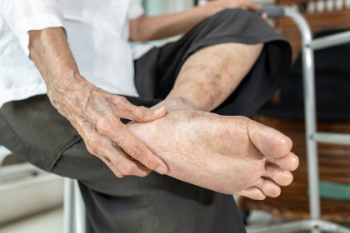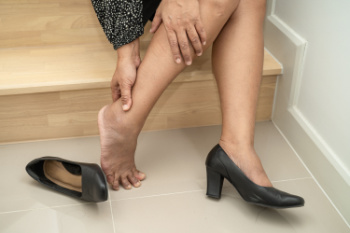April 2024
Diagnosis of Tarsal Tunnel Syndrome
 Tarsal tunnel syndrome, which involves the compression of the posterior tibial nerve as it passes through the tarsal tunnel on the inner side of the ankle, can be tricky to diagnose. Diagnosis typically begins with a physical examination where a podiatrist, or foot doctor, evaluates the foot for signs of nerve compression. The podiatrist may use specific tests that could provoke symptoms. To confirm the diagnosis and eliminate other potential conditions, magnetic resonance Imaging, or an MRI scan is commonly used. An MRI can provide clear images of the soft tissues surrounding the ankle, helping to identify any abnormalities like tumors, varicose veins, or structural deformities compressing the nerve. The treatment strategy may vary depending on MRI findings. For example, if the MRI reveals a structural anomaly compressing the nerve, surgical intervention may be required to alleviate the pressure. However, if inflammation is mild and no significant anatomical issues are detected, more conservative treatments like corticosteroid injections or custom orthotics might be effective. For proper diagnosis of tarsal tunnel syndrome and the most effective treatment plan, it is suggested that you consult a podiatrist.
Tarsal tunnel syndrome, which involves the compression of the posterior tibial nerve as it passes through the tarsal tunnel on the inner side of the ankle, can be tricky to diagnose. Diagnosis typically begins with a physical examination where a podiatrist, or foot doctor, evaluates the foot for signs of nerve compression. The podiatrist may use specific tests that could provoke symptoms. To confirm the diagnosis and eliminate other potential conditions, magnetic resonance Imaging, or an MRI scan is commonly used. An MRI can provide clear images of the soft tissues surrounding the ankle, helping to identify any abnormalities like tumors, varicose veins, or structural deformities compressing the nerve. The treatment strategy may vary depending on MRI findings. For example, if the MRI reveals a structural anomaly compressing the nerve, surgical intervention may be required to alleviate the pressure. However, if inflammation is mild and no significant anatomical issues are detected, more conservative treatments like corticosteroid injections or custom orthotics might be effective. For proper diagnosis of tarsal tunnel syndrome and the most effective treatment plan, it is suggested that you consult a podiatrist.
Tarsal tunnel syndrome can be very uncomfortable to live with. If you are experiencing tarsal tunnel syndrome, contact Milos Tomich, DPM of Dr. Tomich Foot & Ankle Health Center. Our doctor can provide the care you need to keep you pain-free and on your feet.
Tarsal Tunnel Syndrome
Tarsal tunnel syndrome, which can also be called tibial nerve dysfunction, is an uncommon condition of misfiring peripheral nerves in the foot. The tibial nerve is the peripheral nerve in the leg responsible for sensation and movement of the foot and calf muscles. In tarsal tunnel syndrome, the tibial nerve is damaged, causing problems with movement and feeling in the foot of the affected leg.
Common Cause of Tarsal Tunnel Syndrome
- Involves pressure or an injury, direct pressure on the tibial nerve for an extended period of time, sometimes caused by other body structures close by or near the knee.
- Diseases that damage nerves, including diabetes, may cause tarsal tunnel syndrome.
- At times, tarsal tunnel syndrome can appear without an obvious cause in some cases.
The Effects of Tarsal Tunnel Syndrome
- Different sensations, an afflicted person may experience pain, tingling, burning or other unusual sensations in the foot of the affected leg.
- The foot muscles, toes and ankle become weaker, and curling your toes or flexing your foot can become difficult.
- If condition worsens, infections and ulcers may develop on the foot that is experiencing the syndrome.
A physical exam of the leg can help identify the presence of tarsal tunnel syndrome. Medical tests, such as a nerve biopsy, are also used to diagnose the condition. Patients may receive physical therapy and prescriptive medication. In extreme cases, some may require surgery.
If you have any questions please feel free to contact one of our offices located in Milwaukee and Wauwatosa, WI . We offer the newest diagnostic and treatment technologies for all your foot and ankle needs.
Infected Ingrown Toenails
 Ingrown toenails are among the most common and painful foot issues people face. An ingrown toenail occurs when the edge or corner of the toenail grows into the surrounding skin, causing irritation, redness, swelling, and pain. If left untreated, ingrown toenails can become infected, leading to more severe discomfort and potentially serious complications. Podiatrists, or foot doctors, specialize in treating ingrown toenails and offer effective solutions to alleviate the pain associated with this condition. When you visit a podiatrist for an infected ingrown toenail, they will first assess the severity of the problem. Targeted treatment typically involves gently trimming or removing the ingrown portion of the nail, along with providing relief for any associated infection. Podiatrists can also offer guidance on proper nail care techniques to help prevent future occurrences. If you're dealing with the discomfort of an ingrown toenail, it is suggested that you schedule an appointment with a podiatrist.
Ingrown toenails are among the most common and painful foot issues people face. An ingrown toenail occurs when the edge or corner of the toenail grows into the surrounding skin, causing irritation, redness, swelling, and pain. If left untreated, ingrown toenails can become infected, leading to more severe discomfort and potentially serious complications. Podiatrists, or foot doctors, specialize in treating ingrown toenails and offer effective solutions to alleviate the pain associated with this condition. When you visit a podiatrist for an infected ingrown toenail, they will first assess the severity of the problem. Targeted treatment typically involves gently trimming or removing the ingrown portion of the nail, along with providing relief for any associated infection. Podiatrists can also offer guidance on proper nail care techniques to help prevent future occurrences. If you're dealing with the discomfort of an ingrown toenail, it is suggested that you schedule an appointment with a podiatrist.
Ingrown toenails may initially present themselves as a minor discomfort, but they may progress into an infection in the skin without proper treatment. For more information about ingrown toenails, contact Milos Tomich, DPM of Dr. Tomich Foot & Ankle Health Center. Our doctor can provide the care you need to keep you pain-free and on your feet.
Ingrown Toenails
Ingrown toenails are caused when the corner or side of a toenail grows into the soft flesh surrounding it. They often result in redness, swelling, pain, and in some cases, infection. This condition typically affects the big toe and may recur if it is not treated properly.
Causes
- Improper toenail trimming
- Genetics
- Improper shoe fitting
- Injury from pedicures or nail picking
- Abnormal gait
- Poor hygiene
You are more likely to develop an ingrown toenail if you are obese, have diabetes, arthritis, or have any fungal infection in your nails. Additionally, people who have foot or toe deformities are at a higher risk of developing an ingrown toenail.
Symptoms
Some symptoms of ingrown toenails are redness, swelling, and pain. In rare cases, there may be a yellowish drainage coming from the nail.
Treatment
Ignoring an ingrown toenail can have serious complications. Infections of the nail border can progress to a deeper soft-tissue infection, which can then turn into a bone infection. You should always speak with your podiatrist if you suspect you have an ingrown toenail, especially if you have diabetes or poor circulation.
If you have any questions, please feel free to contact one of our offices located in Milwaukee and Wauwatosa, WI . We offer the newest diagnostic and treatment technologies for all your foot care needs.
Heel Pain Can Be Treated!
Risk Factors for Falling

As people age, the risk of a fall increases, but it should not be seen as inevitable. Falls can be caused by various factors, including weak muscles, poor balance, and dizziness. Foot problems like pain or deformities, and cognitive issues such as memory loss, and vision and hearing impairments, can also contribute to the risk of falls in seniors. Medications that induce drowsiness, excessive alcohol consumption, and certain bladder or bowel conditions can increase the likelihood of falling. Falls often result from an interaction of these factors, with a higher number of risk factors further elevating the potential for falls. In addition, falls can sometimes signal underlying health issues like constipation, infections, dehydration, or sudden confusion. A podiatrist can provide expert advice and interventions to address foot-related problems, improve balance, and reduce the risk of future falls. If instability causes you to lose your balance or fall frequently, it is suggested that you schedule an appointment with a podiatrist for a thorough exam and options for treatment.
Preventing falls among the elderly is very important. If you are older and have fallen or fear that you are prone to falling, consult with Milos Tomich, DPM from Dr. Tomich Foot & Ankle Health Center. Our doctor will assess your condition and provide you with quality advice and care.
Every 11 seconds, an elderly American is being treated in an emergency room for a fall related injury. Falls are the leading cause of head and hip injuries for those 65 and older. Due to decreases in strength, balance, senses, and lack of awareness, elderly persons are very susceptible to falling. Thankfully, there are a number of things older persons can do to prevent falls.
How to Prevent Falls
Some effective methods that older persons can do to prevent falls include:
- Enrolling in strength and balance exercise program to increase balance and strength
- Periodically having your sight and hearing checked
- Discuss any medications you have with a doctor to see if it increases the risk of falling
- Clearing the house of falling hazards and installing devices like grab bars and railings
- Utilizing a walker or cane
- Wearing shoes that provide good support and cushioning
- Talking to family members about falling and increasing awareness
Falling can be a traumatic and embarrassing experience for elderly persons; this can make them less willing to leave the house, and less willing to talk to someone about their fears of falling. Doing such things, however, will increase the likelihood of tripping or losing one’s balance. Knowing the causes of falling and how to prevent them is the best way to mitigate the risk of serious injury.
If you have any questions, please feel free to contact one of our offices located in Milwaukee and Wauwatosa, WI . We offer the newest diagnostic and treatment technologies for all your foot care needs.
How Shoe Choice Can Cause Hind-Foot Pain
 Wearing improper footwear, particularly shoes that lack adequate support or fit poorly, can significantly contribute to hind-foot pain. High heels and narrow-toed shoes, while fashionable, can place excessive stress on the structures of the hind-foot. The heel and ankle are two particularly susceptible areas for pain. Wearing these kinds of shoes can also lead to conditions like plantar fasciitis, Achilles tendonitis, and bursitis. These styles force the foot into an unnatural position, disrupting alignment and increasing pressure on the back of the foot. Stress on the foot over time not only leads to pain and discomfort but also can significantly affect mobility and quality of life. It is important to choose shoes with proper support, cushioning, and a fit that accommodates the natural shape of the foot to prevent hind-foot pain. Podiatrists often stress the importance of wearing shoes that complement one's lifestyle as well as provide the foundation for healthy foot posture and function. If you are experiencing pain in the back of the foot, it is suggested that you visit a podiatrist for a full diagnosis and proper shoe recommendations to support your recovery.
Wearing improper footwear, particularly shoes that lack adequate support or fit poorly, can significantly contribute to hind-foot pain. High heels and narrow-toed shoes, while fashionable, can place excessive stress on the structures of the hind-foot. The heel and ankle are two particularly susceptible areas for pain. Wearing these kinds of shoes can also lead to conditions like plantar fasciitis, Achilles tendonitis, and bursitis. These styles force the foot into an unnatural position, disrupting alignment and increasing pressure on the back of the foot. Stress on the foot over time not only leads to pain and discomfort but also can significantly affect mobility and quality of life. It is important to choose shoes with proper support, cushioning, and a fit that accommodates the natural shape of the foot to prevent hind-foot pain. Podiatrists often stress the importance of wearing shoes that complement one's lifestyle as well as provide the foundation for healthy foot posture and function. If you are experiencing pain in the back of the foot, it is suggested that you visit a podiatrist for a full diagnosis and proper shoe recommendations to support your recovery.
Foot Pain
Foot pain can be extremely painful and debilitating. If you have a foot pain, consult with Milos Tomich, DPM from Dr. Tomich Foot & Ankle Health Center. Our doctor will assess your condition and provide you with quality foot and ankle treatment.
Causes
Foot pain is a very broad condition that could be caused by one or more ailments. The most common include:
- Bunions
- Hammertoes
- Plantar Fasciitis
- Bone Spurs
- Corns
- Tarsal Tunnel Syndrome
- Ingrown Toenails
- Arthritis (such as Gout, Rheumatoid, and Osteoarthritis)
- Flat Feet
- Injury (from stress fractures, broken toe, foot, ankle, Achilles tendon ruptures, and sprains)
- And more
Diagnosis
To figure out the cause of foot pain, podiatrists utilize several different methods. This can range from simple visual inspections and sensation tests to X-rays and MRI scans. Prior medical history, family medical history, and any recent physical traumatic events will all be taken into consideration for a proper diagnosis.
Treatment
Treatment depends upon the cause of the foot pain. Whether it is resting, staying off the foot, or having surgery; podiatrists have a number of treatment options available for foot pain.
If you have any questions, please feel free to contact one of our offices located in Milwaukee and Wauwatosa, WI . We offer the newest diagnostic and treatment technologies for all your foot care needs.
Ankle Joint Replacement Surgery for Arthritis Relief
 Joint replacement for ankle arthritis is a surgical option for those suffering from severe arthritis in their ankle. The point of the replacement surgery is to relieve pain and restore the function of the ankle. Arthritis is characterized by the breakdown of cartilage that cushions the ends of the bones, leading to pain, stiffness, and reduced mobility. During ankle joint replacement surgery, also known as ankle arthroplasty, the damaged parts of the ankle bones are removed and replaced with artificial components. These components mimic the natural movement of the ankle, offering patients the chance to regain mobility. This procedure is considered when less invasive treatments have failed to provide relief. It is also considered mostly for older, less active patients. Joint replacement can significantly reduce pain and improve the ankle's function, making it a valuable treatment option for those with advanced ankle arthritis. If you are suffering from arthritis in the ankle, it is suggested that you schedule an appointment with a podiatrist to discuss whether ankle replacement surgery is right for you.
Joint replacement for ankle arthritis is a surgical option for those suffering from severe arthritis in their ankle. The point of the replacement surgery is to relieve pain and restore the function of the ankle. Arthritis is characterized by the breakdown of cartilage that cushions the ends of the bones, leading to pain, stiffness, and reduced mobility. During ankle joint replacement surgery, also known as ankle arthroplasty, the damaged parts of the ankle bones are removed and replaced with artificial components. These components mimic the natural movement of the ankle, offering patients the chance to regain mobility. This procedure is considered when less invasive treatments have failed to provide relief. It is also considered mostly for older, less active patients. Joint replacement can significantly reduce pain and improve the ankle's function, making it a valuable treatment option for those with advanced ankle arthritis. If you are suffering from arthritis in the ankle, it is suggested that you schedule an appointment with a podiatrist to discuss whether ankle replacement surgery is right for you.
In certain cases, in which the patient suffers from extreme pain or damage in a joint, joint replacement surgery may be deemed useful. If you have constant pain in a foot joint, consult with Milos Tomich, DPM from Dr. Tomich Foot & Ankle Health Center. Our doctor will assess your condition and provide you with quality foot and ankle treatment.
What Is Joint Replacement Surgery?
Over time, joints wear down; this can be exacerbated by diseases and conditions. Joint replacement surgery, also known as arthroplasty, is when a damaged joint is surgically removed and replaced with a prosthesis. Prostheses, which can be made of ceramic, plastic, or metal, act as joints in lieu of an actual joint. One of the most prevalent causes for joint replacement is arthritis.
Arthritis in the Foot
Arthritis can occur in any joint in the body, including in the feet. Common types of arthritis in the foot are osteoarthritis, rheumatoid arthritis, and gout. The big toe is usually where arthritis occurs in the foot; this is known as hallux rigidus.
Joint Replacement Surgery in the Foot
The most common form of joint replacement in the foot is a first metatarsophalangeal (MTP) joint placement. MTP joint replacement surgery is designed to treat hallux rigidus. Surgery is not intensive, and recovery occurs within one to two months after the procedure has been done. Overall, joint replacement surgery is a safe and effective way to treat pain in the joint of the foot.
If you have any questions, please feel free to contact one of our offices located in Milwaukee and Wauwatosa, WI . We offer the newest diagnostic and treatment technologies for all your foot care needs.





